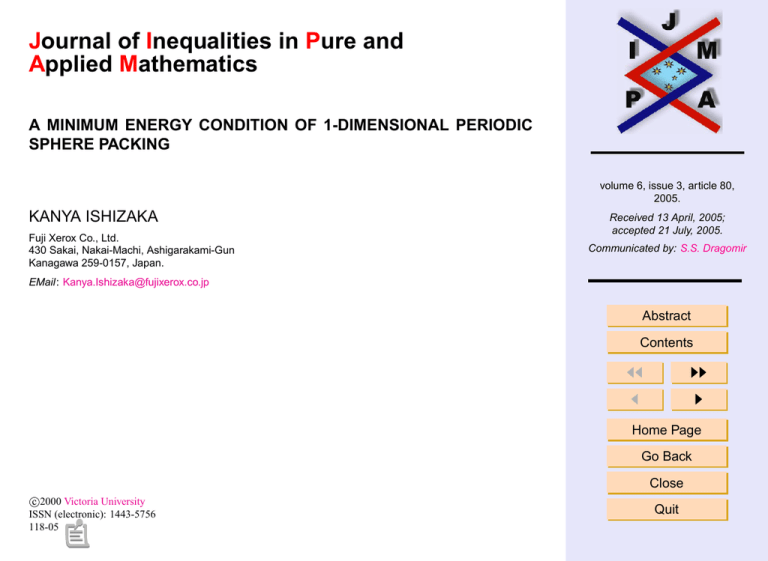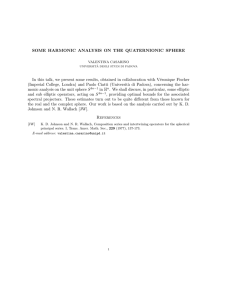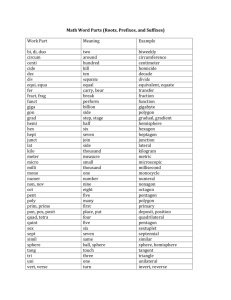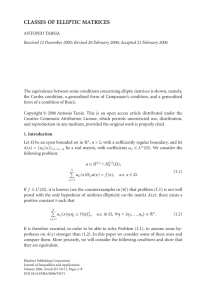J I P A
advertisement

Journal of Inequalities in Pure and
Applied Mathematics
A MINIMUM ENERGY CONDITION OF 1-DIMENSIONAL PERIODIC
SPHERE PACKING
volume 6, issue 3, article 80,
2005.
KANYA ISHIZAKA
Fuji Xerox Co., Ltd.
430 Sakai, Nakai-Machi, Ashigarakami-Gun
Kanagawa 259-0157, Japan.
Received 13 April, 2005;
accepted 21 July, 2005.
Communicated by: S.S. Dragomir
EMail: Kanya.Ishizaka@fujixerox.co.jp
Abstract
Contents
JJ
J
II
I
Home Page
Go Back
Close
c
2000
Victoria University
ISSN (electronic): 1443-5756
118-05
Quit
Abstract
Let X ⊂ R/Z be a non-empty finite set and f(x) be a real-valued function on
[0, 12 ]. Let an energy of X be the average value of f(kx − yk) for x, y ∈ X where
k·k is the Euclidean distance on R/Z. Let Xn ⊂ R/Z be an equally spaced npoint set. It is shown that if f is monotone decreasing and convex, then among
all n-point sets, the energy is minimized by Xn . Moreover, by giving a variant
1
of a result of Bennett and Jameson, it is shown that if f is convex, f 0 (x 2 ) is
concave and limx→ 1 f 0 (x) = 0, then the energy of Xn decreases with n.
2
A Minimum Energy Condition of
1-Dimensional Periodic Sphere
Packing
Kanya Ishizaka
2000 Mathematics Subject Classification: 05B40, 74G65.
Key words: Packing, Energy, One-dimension.
Contents
Title Page
Contents
1
Introduction . . . . . . . . . . . . . . . . . . . . . . . . . . . . . . . . . . . . . . . . . 3
2
Definition and Preliminaries . . . . . . . . . . . . . . . . . . . . . . . . . . . 5
3
Global Minimum Condition for Fixed n . . . . . . . . . . . . . . . . . . 7
4
Monotone Decreasing Condition with n . . . . . . . . . . . . . . . . . . 10
5
Summary and Examples . . . . . . . . . . . . . . . . . . . . . . . . . . . . . . . 15
References
JJ
J
II
I
Go Back
Close
Quit
Page 2 of 19
J. Ineq. Pure and Appl. Math. 6(3) Art. 80, 2005
http://jipam.vu.edu.au
1.
Introduction
In digital imaging technologies, sometimes we are required to give well-dispersed
points or measure the goodness of point dispersion. For example, in digital
halftoning technology, there is a method called dispersed dot halftoning that
provides a binary image where many small dispersed dots represent each tone
of an original continuous tone image. Therefore, we want to focus on the mathematics of well-dispersed point sets’ structures or estimating functions that can
measure the goodness of dispersed point sets.
From a purely mathematical point of view, "sphere packing problems," are
problems which are concerned with well-dispersed points. The sphere packing
problems contain the problem that asks the maximum value of the minimum distance among every two points of all n dispersed point sets in the p-dimensional
unit square and ask its structure [3, 5, 6]. On the other hand, in order to measure
the goodness of dispersed points, there are some problems of the type that ask
for a placement of points which minimize or maximize a given energy [2, 4, 3].
In general, these two problems are hard to deal with in spaces higher than
2-dimensions. However, we expect that a solution in a 1-dimensional space
will give us some useful hints for applications to digital imaging technologies.
For this purpose, we also need to combine these two problems. The reason
why the usage of the sphere packing idea itself is problematic in digital discrete
spaces, is because in the spaces, placements of points are limited and it is hard
to remove local distortions without using the idea of energies.
Therefore, we would like to investigate the problem "if the sphere packing
placement in a 1-dimensional space minimizes some energy value among every
two points". For ease of analysis, we impose the target space on symmetry,
A Minimum Energy Condition of
1-Dimensional Periodic Sphere
Packing
Kanya Ishizaka
Title Page
Contents
JJ
J
II
I
Go Back
Close
Quit
Page 3 of 19
J. Ineq. Pure and Appl. Math. 6(3) Art. 80, 2005
http://jipam.vu.edu.au
that is, we work on the periodic sphere packing case [5, pp. 25]. In fact,
the periodic sphere packing placement in a 1-dimensional space is precisely
calculated as an equally spaced set with periodic boundary. Hence, the energy
value is precisely calculated, too. Therefore, the interest is to investigate the
condition and property of the energy itself that takes the minimum value when
given points are equally spaced points.
For the above reasons, we investigate the following two points.
(A). A global minimum condition of the energy of equally spaced n-point sets.
(B). A condition so that the energy of equally spaced n-point sets decreases with
n.
A Minimum Energy Condition of
1-Dimensional Periodic Sphere
Packing
Kanya Ishizaka
Title Page
Contents
JJ
J
II
I
Go Back
Close
Quit
Page 4 of 19
J. Ineq. Pure and Appl. Math. 6(3) Art. 80, 2005
http://jipam.vu.edu.au
2.
Definition and Preliminaries
Definition 2.1. Let E = [0, 1). Let the distance kx − yk between two points
x, y ∈ E be
kx − yk = min {|x − y + e| : e = −1, 0, 1} .
LetX ⊂ (E, k·k) be a non-empty finite set. Let f be any real-valued function
on 0, 21 . Then, let the energy of a point x ∈ X be
I(X, x, f ) =
1 X
f (kx − yk)
|X| y∈X
and the energy of the set X be
I(X, f ) =
1 X
1 XX
I(X, x, f ) =
f (kx − yk) ,
|X| x∈X
|X|2 x∈X y∈X
where |X| means the cardinality of X. Let Xn ⊂ (E, k·k) denote an equally
spaced n-point set.
The space (E, k·k) is metrically equivalent to the circle S 1 with the arcwise
distance, and locally equivalent to R. By the definition of (E, k·k), kx−yk ≤ 12
holds for any x, y ∈ (E, k·k).
Remark 1. To compare energies for fixed f , we can assume f 12 = 0, because energies are written by I(X, x, f ) =I(X, x, g)+ f 12 and I(X, f ) =
I(X, g) + f 21 where g(x) = f (x) − f 12 with g 12 = 0. Moreover, we can
A Minimum Energy Condition of
1-Dimensional Periodic Sphere
Packing
Kanya Ishizaka
Title Page
Contents
JJ
J
II
I
Go Back
Close
Quit
Page 5 of 19
J. Ineq. Pure and Appl. Math. 6(3) Art. 80, 2005
http://jipam.vu.edu.au
extend f onto
1
,∞
2
by f (x) = f
1
2
= 0. Then,
n
(2.1)
(2.2)
2X
1
I(Xn , x, f ) = f (0) +
f
n
n i=1
i
,
n
I(Xn , f ) = I(Xn , x, f )
hold for any Xn ⊂ (E, k·k) and x ∈ Xn .
A Minimum Energy Condition of
1-Dimensional Periodic Sphere
Packing
Kanya Ishizaka
Title Page
Contents
JJ
J
II
I
Go Back
Close
Quit
Page 6 of 19
J. Ineq. Pure and Appl. Math. 6(3) Art. 80, 2005
http://jipam.vu.edu.au
3.
Global Minimum Condition for Fixed n
We investigate the problem (A) and give a sufficient condition so that the minimum energy among n-point sets is given by I(Xn , f ). In a 1-dimensional space,
we do not need a local minimum condition analysis, because we can obtain a
global minimum condition from the following.
Theorem 3.1. Let Y ⊂ (E, k·k) be any n-point set. If f is monotone decreasing
and convex, then I(Y, f ) ≥ I(Xn , f ) holds.
Proof. By Remark 1, we can assume f (x) = 0 x ≥ 12 . Then, by the assumption, f is convex on [0, ∞). Let Y = {yn+1 , . . . , y2n } ⊂ [0, 1) for convenience
and assume
yi ≤ yi+1 (i = n + 1, . . . , 2n − 1).
Moreover, take points on both sides of the set Y as
yi = yi+n − 1 (i = 1, . . . , n)
yi = yi−n + 1 (i = 2n + 1, . . . , 3n).
Then, for {y1 , . . . , y3n } ⊂ [−1, 2),
A Minimum Energy Condition of
1-Dimensional Periodic Sphere
Packing
Kanya Ishizaka
Title Page
Contents
JJ
J
II
I
Go Back
(3.1)
yi ≤ yi+1 (i = 1, . . . , 3n − 1)
holds. Next, let
(3.2)
Close
Quit
di = yi+1 − yi (i = 1, . . . , 3n − 1).
Here, di = di+n = di+2n holds for each i = 1, . . . , n.
Page 7 of 19
J. Ineq. Pure and Appl. Math. 6(3) Art. 80, 2005
http://jipam.vu.edu.au
By (3.1) and (3.2), for each k = n + 1, . . . , 2n and i = 1, . . . , n,
| yk − yk+i | =
(3.3)
i
X
dk+j−1 ,
j=1
| yk − yk−i | =
(3.4)
i
X
dk−j
j=1
holds. In addition, the following hold for each i = 1, . . . , 2n.
n
X
(3.5)
di+j = 1.
Kanya Ishizaka
j=1
By (3.3), (3.4) and f (x) = 0 on x ∈
k = n + 1, . . . , 2n:
1X
(3.6) I(Y, yk , f ) =
f (kyk − yk)
n y∈Y
1
,
∞
, the following holds for each
2
3n
=
A Minimum Energy Condition of
1-Dimensional Periodic Sphere
Packing
1X
f (|yk − yi |)
n i=1
n
n
1X
1
1X
f (|yk − yk+i |) +
f (|yk − yk−i |) + f (0)
=
n i=1
n i=1
n
!
!
n
i
n
i
X
X
1X
1X
1
f
dk+j−1 +
f
dk−j + f (0).
=
n i=1
n i=1
n
j=1
j=1
Title Page
Contents
JJ
J
II
I
Go Back
Close
Quit
Page 8 of 19
J. Ineq. Pure and Appl. Math. 6(3) Art. 80, 2005
http://jipam.vu.edu.au
Since f is convex on [0, ∞), by Jensen’s inequality and by (3.5), (3.6), (2.1)
and (2.2), the following holds.
1X
I(Y, f ) =
I(Y, y, f )
n y∈Y
=
=
=
≥
=
2n
1 X
I(Y, yk , f )
n k=n+1
" n
!
!
#
2n
i
n
i
X
X
X
1 X X
f
dk+j−1 +
f
dk−j + f (0)
n2 k=n+1 i=1
j=1
i=1
j=1
!
!
n
2n
i
n
2n
i
X
X
X
X
X
X
1
1
1
f
dk+j−1 + 2
f
dk−j + f (0)
2
n i=1 k=n+1
n i=1 k=n+1
n
j=1
j=1
"
!#
n
i
2n
1X X
1 X
nf
dk+j−1
n2 i=1
n j=1 k=n+1
"
!#
n
i
2n
X
X
X
1
1
1
+ 2
nf
dk−j
+ f (0)
n i=1
n j=1 k=n+1
n
n
2X
i
1
f
+ f (0)
n i=1
n
n
= I(Xn , f ).
I(Y, f ) > I(Xn , f ) holds when f is bounded and strictly convex on 0, 12 .
This concludes the proof of Theorem 3.1.
A Minimum Energy Condition of
1-Dimensional Periodic Sphere
Packing
Kanya Ishizaka
Title Page
Contents
JJ
J
II
I
Go Back
Close
Quit
Page 9 of 19
J. Ineq. Pure and Appl. Math. 6(3) Art. 80, 2005
http://jipam.vu.edu.au
4.
Monotone Decreasing Condition with n
We investigate Problem (B) and give a sufficient condition so that the energy
I(Xn , f ) decreases with n. For this, we give a variant of a result of Bennett
and
R1
Jameson [1, Theorem 5]. Let Tn (f ) be the trapezium estimate for 0 f given
by dividing [0, 1] into n equal subintervals:
n−1 1 X
i
i+1
Tn (f ) =
f
+f
.
2n i=0
n
n
The result of [1] is that if f is convex and f 0 is either convex or concave, then
1
Tn (f ) decreases with n. Here we show the same holds if f is convex, f 0 x 2 is
concave and limx→1 f 0 (x) = 0.
Theorem
4.1. Let f be a differentiable function on [0, 1]. If f (x) is convex,
1
0
2
f x is concave and lim f 0 (x) = 0, then Tn (f ) decreases with n.
x→1
Proof. Without loss of generality, we can assume f (1) = 0. Extend f onto
(1, ∞) by f (x) = f (1) = 0. Then, f is differentiable convex on [0, ∞). For a
real number a ≥ 1, extend Tn (f ) by
A Minimum Energy Condition of
1-Dimensional Periodic Sphere
Packing
Kanya Ishizaka
Title Page
Contents
JJ
J
II
I
Go Back
[a] 1 X
i
i+1
Ta (f ) =
f
+f
.
2a i=0
a
a
Here, if a is a natural number, then [a] can be replaced by a − 1. We show that
Ta (f ) decreases with a ≥ 1 by analyzing the differential coefficient of Ta (f )
for a. The differentiability of Ta (f ) for a is guaranteed by the fact that f is
Close
Quit
Page 10 of 19
J. Ineq. Pure and Appl. Math. 6(3) Art. 80, 2005
http://jipam.vu.edu.au
differentiable on [0, ∞) and f (x) = f 0 (x) = 0 for x ≥ 1. In fact, the differential
coefficient Ta 0 (f ) is expressed by Ta 0 (f ) = − a12 · Sa (f ) where Sa (f ) is given
by the following.
[a] X
i
i+1
i 0 i
i+1 0 i+1
Sa (f ) =
f
+ f
+f
+
f
.
a
a
a
a
a
a
i=0
Thus, it is enough to show that Sa (f ) ≥ 0 for a ≥ 1.
In the following, we show Sn (f ) ≥ 0 for any natural number n. Let g(x) =
1
x 2 . Here, f 0 ◦ g is concave on [0, ∞), because f 0 ◦ g is concave on [0, 1] and
f 0 (x) = 0 (x ≥ 1). Hence, we get the following inequality for i by considering
the trapezium estimate for the integral of f 0 ◦ g (Figure 1).
Z
i2 +i
n2
i2 −i
n2
2 !
i
2i 0 i
= 2f
.
n
n
n
2i
f ◦ g(x)dx ≤ 2 f 0 ◦ g
n
0
Thus, by remarking f (x) = f 0 (x) = 0 on x ≥ 1, we get the following.
2
X
n Z i +i
n
X
n2
2i 0 i
f 0 ◦ g(x)dx
f
≥
2
2
i
−i
n
n
i=0
i=0
n2
Z 1
=
f 0 ◦ g(x)dx
0
Z 1
Z
1
= 2 [xf (x)]0 − 2
f (x)dx = −2
0
0
A Minimum Energy Condition of
1-Dimensional Periodic Sphere
Packing
Kanya Ishizaka
Title Page
Contents
JJ
J
II
I
Go Back
Close
Quit
Page 11 of 19
1
f (x)dx.
J. Ineq. Pure and Appl. Math. 6(3) Art. 80, 2005
http://jipam.vu.edu.au
Therefore, by remarking that f 0 (x) = 0 on x ≥ 1 again, we obtain:
n−1 X
i+1
i
i 0 i
i+1 0 i+1
Sn (f ) =
f
+f
+ f
+
f
n
n
n
n
n
n
i=0
n−1 X
i
i+1
2 0 i
=
f
+f
+ if
n
n
n
n
i=0
X
n
n−1 X
i+1
i
2 0 i
=
+f
+
if
f
n
n
n
n
i=0
i=0
Z 1
n−1
X
i+1
i
≥
f
+f
− 2n
f (x)dx
n
n
0
i=0
≥ 0.
The last inequality holds by the the trapezium estimate for the integral of f
which is convex on [0, 1]. Thus, Sn (f ) ≥ 0 holds for any natural number n.
1
We note again the condition that f is convex on [0, ∞), f 0 x 2 is concave
on [0, ∞) and f (x) = f 0 (x) = 0 for x ≥ 1. Then, we get Sa (f ) ≥ 0 for any
real number a ≥ 1 in the same manner as for natural number n.
Therefore, Tn (f ) decreases with n. Tn (f ) strictly decreases with n when f
is bounded and strictly convex on [0, 1]. By the assumption of this theorem, f
is indeed a monotone decreasing C 1 class function. This concludes the proof of
Theorem 4.1.
Now we apply Theorem 4.1 to the energy.
A Minimum Energy Condition of
1-Dimensional Periodic Sphere
Packing
Kanya Ishizaka
Title Page
Contents
JJ
J
II
I
Go Back
Close
Quit
Page 12 of 19
J. Ineq. Pure and Appl. Math. 6(3) Art. 80, 2005
http://jipam.vu.edu.au
( i −n1 )2
i −1
n2
(i +n1 )2
( ni )2
i
n2
i +1
n2
i
n2
( i +n2 )2
i+1
n2
i+ 2
n2
f 'o g ( x )
2i
n2
f 'o g
(( ) ) =
i 2
n
2i
n2
A Minimum Energy Condition of
1-Dimensional Periodic Sphere
Packing
f ' ( ni )
Kanya Ishizaka
Figure 1: A trapezium estimate for the integral of the concave function f 0 ◦ g
1
where g(x) = x 2 .
1
Corollary 4.2. If f (x) is differentiable convex, f 0 x 2 is concave and lim1 f 0 (x) =
x→ 2
0, then I(Xn , f ) decreases with n.
Proof. By Remark 1, we can assume f (x) = 0 x ≥ 12 and then I(Xn , f ) =
2Tn (f ) holds by (2.1) and (2.2). By the assumption, f is differentiable on [0, 1]
with limx→1 f 0 (x) = 0. Hence, by Theorem 4.1, I(Xn , f ) decreases with
n.
Title Page
Contents
JJ
J
II
I
Go Back
Close
Quit
Page 13 of 19
Although Theorem 3.1 guarantees that the energy is minimized by equally
J. Ineq. Pure and Appl. Math. 6(3) Art. 80, 2005
http://jipam.vu.edu.au
spaced points, it does not necessarily guarantee that the energy takes lower value
by more dispersed points. Corollary 4.2 guarantees the latter matter and reinforces Theorem 3.1.
A Minimum Energy Condition of
1-Dimensional Periodic Sphere
Packing
Kanya Ishizaka
Title Page
Contents
JJ
J
II
I
Go Back
Close
Quit
Page 14 of 19
J. Ineq. Pure and Appl. Math. 6(3) Art. 80, 2005
http://jipam.vu.edu.au
5.
Summary and Examples
We summarize the previous results in the following Corollary 5.1 by changing
f to a real-valued function Rh Rdefined on [0, 1]. In potential theory, potential
energies are determined as
|x − y|−s dµ(x)dµ(y) for real number s [2].
However, it is convenient to give the sphere of influence r (0 < r ≤ 12 ) for each
point, for our purpose of application to digital imaging technologies, for ease
of calculations. That is, points that are placed in a distance larger than r from a
noticed point do not influence the energy.
1
.
2
Corollary 5.1. Let r be 0 < r ≤
For the energy defined by Definition 2.1,
let
|x − y|
h
, |x − y| < r
f (|x − y|) =
r
0,
|x − y| ≥ r
where h is a real-valued function on [0, 1]. Assume that the following conditions
are satisfied.
(H1) h(x) is monotone decreasing.
(H2) h(x) is differentiable on [0, 1].
(H3) h(1) = 0.
(H4) limx→1 h0 (x) = 0.
(H5) h(x) is convex.
1
(H6) h0 (x 2 ) is concave.
Then, for any m-point set Y ⊂ (E, k·k) with 1 ≤ m ≤ n, I(Y, f ) ≥ I(Xn , f )
holds.
Proof. From H2, H3 and H4, f is differentiable. From H1 and H5, f (x) is
A Minimum Energy Condition of
1-Dimensional Periodic Sphere
Packing
Kanya Ishizaka
Title Page
Contents
JJ
J
II
I
Go Back
Close
Quit
Page 15 of 19
J. Ineq. Pure and Appl. Math. 6(3) Art. 80, 2005
http://jipam.vu.edu.au
1
monotone decreasing and convex. From H4 and H6, f 0 x 2 is concave on 0, 12
and limx→ 1 f 0 (x) = 0. Hence, by Theorem 3.1 and Corollary 4.2, I(Y, f ) ≥
2
I(Xn , f ) holds. I(Y, f ) > I(Xn , f ) holds when h is bounded, strictly convex
on [0, 1] and r ≥ n1 . In fact, the condition H1 is derived from H4 and H5. From
H2 and H6, h is indeed a C 1 class function.
We give the following examples for the function h of the Corollary 5.1.
Let p > 0. In the following, we consider four examples as the function h.
Example 5.1. h1 (x) = (1 − x)p .
1
h1 (x) is monotone decreasing and convex if and only if p ≥ 1. Since h1 0 x 2 =
1
−p(1 − x 2 )p−1 , H1-H6 all hold for p ≥ 2. In the case of p = 1, H4 and H6 do
not hold. In the case of 1 < p < 2, H6 does not hold.
p
Example 5.2. h2 (x) = 23 − x + 13 x3 .
h2 (x) is monotone decreasing and convex if and only if p ≥ 1. Since h2 0 (x) =
p−1
1
p 23 − x + 31 x3
· (x2 − 1), h2 0 x 2 is concave when p ≥ 1, too. Thus, in
the case of p ≥ 1, H1-H6 all hold. This function gives the power of p value of
the intersection volume of two 3-dimensional balls with diameter 1, where the
center points of these balls are placed with distance x (Figure 2(upper)).
Example 5.3. h3 (x) = 1 − x + x(xp − 1)/p.
h3 (x) is monotone decreasing and convex for all p > 0. In the case of p = 1,
h3 (x) equals to the function h1 (x) with p = 2, and in the case of p = 2, h3 (x)
equals to the function 23 h2 (x) with p = 1. As p goes to infinity, h3 (x) converges
1
to the function 1 − x. Since h3 0 (x) = −1 + (p + 1)/pxp − 1/p, h3 0 x 2 is
concave when 0 < p ≤ 2 and H1-H6 all hold. In the case of p > 2, H6 does
not hold.
A Minimum Energy Condition of
1-Dimensional Periodic Sphere
Packing
Kanya Ishizaka
Title Page
Contents
JJ
J
II
I
Go Back
Close
Quit
Page 16 of 19
J. Ineq. Pure and Appl. Math. 6(3) Art. 80, 2005
http://jipam.vu.edu.au
p
Example 5.4. h4 (x) = 2 cos−1 (x) − sin(2 cos−1 (x)) .
h4 (x) is monotone decreasing and convex when p ≥ 1. Since
p−1
−2
·√
h4 0 (x) = p 2 cos−1 (x) − sin(2 cos−1 (x))
·(1−cos(2 cos−1 (x))),
1 − x2
1
one can check that h4 0 x 2 is concave if p is to some extent large, for example
1
p > 1.5. At least, in the case of p = 1, h4 0 x 2 is not concave. This function
gives the power of p value of the intersection area of two circles with diameter
1, where the center points of these circles are placed with distance x (Figure
2(lower)). Therefore, although the function h2 with p = 1, which is the volume
of the cross region of 2 balls, satisfies the condition H1-H6, the function h4 with
p = 1, which is the area of the cross region of 2 circles, does not satisfy the
condition H6.
A Minimum Energy Condition of
1-Dimensional Periodic Sphere
Packing
Kanya Ishizaka
Title Page
Contents
JJ
J
II
I
Go Back
Close
Quit
Page 17 of 19
J. Ineq. Pure and Appl. Math. 6(3) Art. 80, 2005
http://jipam.vu.edu.au
1
1
2
1
2
x
1
4
π [ 23 − x + 13 x 3 ]
A Minimum Energy Condition of
1-Dimensional Periodic Sphere
Packing
intersection
volume of 2 equal balls
Kanya Ishizaka
Title Page
1
Contents
1
2
1
2
JJ
J
x
II
I
Go Back
−1
cos ( x )
1
4
[ 2 cos −1 ( x ) − sin( 2 cos −1 ( x ))]
Close
intersection
area of 2 equal circles
Figure 2: Illustrations of functions h2 (x) (upper) and h4 (x) (lower).
Quit
Page 18 of 19
J. Ineq. Pure and Appl. Math. 6(3) Art. 80, 2005
http://jipam.vu.edu.au
References
[1] G. BENNETT AND G. JAMESON, Monotonic averages of convex functions, J. Math. Anal. Appl., 252 (2000), 410–430.
[2] G. BJÖRCK, Distributions of positive mass which maximize a certain generalized energy integral, Arkiv for Math., 3 (1955), 255–269.
[3] H.T. CROFT, K.J. FALCONER AND R.K. GUY, Unsolved Problems in Geometry, Springer Verlag, Reissue edition, 1995.
[4] L. FEJES TÓTH, On the sum of distances determined by a point set, Acta
Math.Acad.Sci.Hung., 7 (1956), 397–401.
A Minimum Energy Condition of
1-Dimensional Periodic Sphere
Packing
Kanya Ishizaka
[5] C.A. ROGERS, Packing and Covering, Cambridge University Press, 1964.
[6] C. ZONG, Sphere Packings (Universitext), Springer Verlag, 1999.
Title Page
Contents
JJ
J
II
I
Go Back
Close
Quit
Page 19 of 19
J. Ineq. Pure and Appl. Math. 6(3) Art. 80, 2005
http://jipam.vu.edu.au



